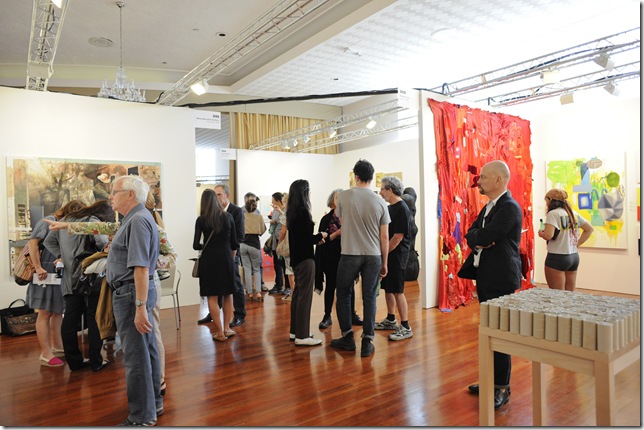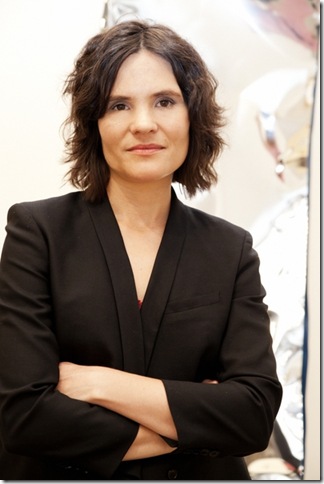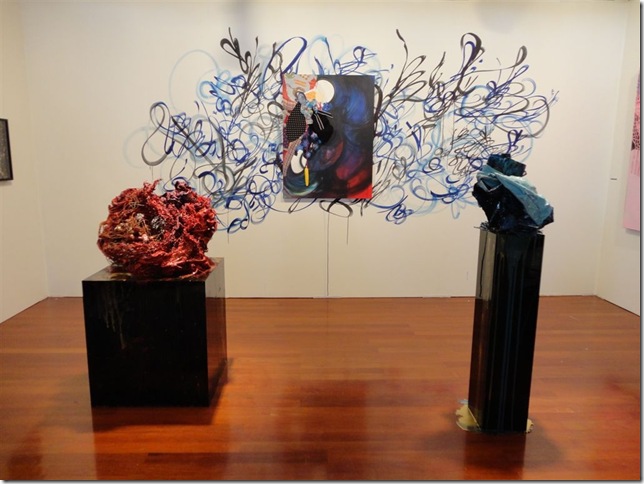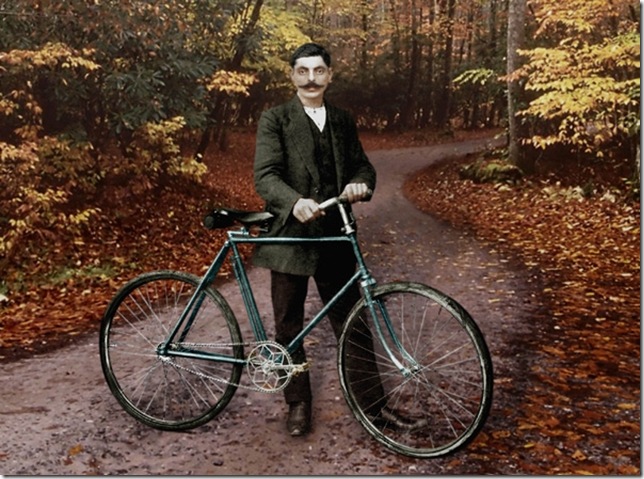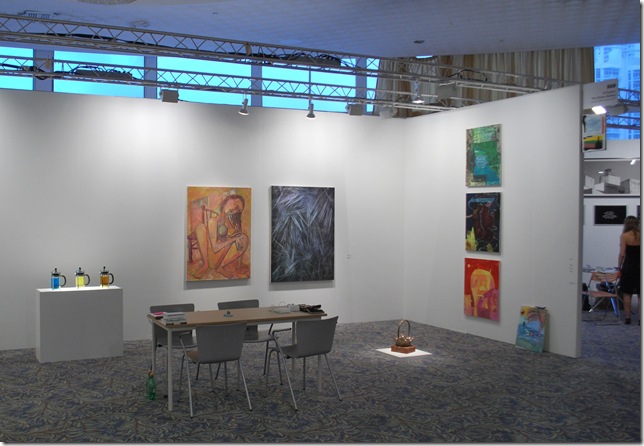On the first day of the New Art Dealers Alliance art fair (NADA), which took place during the recent Miami Art Week, young artists and art professionals gathered alongside established dealers, collectors and curators in the expansive grand lobby of the Deauville Beach Resort.
Young men with scruffy beards wearing blue jeans sat on couches and armchairs alongside polished art world mavens in Prada to watch Hennessy Youngman’s performance work, History of Art Part 1, a Joyce-like, stream-of-consciousness rap with wry observations about art-world elitism and racism.
The vibe was casual, and the comfortable mingling of emerging and established in what, at times, felt more like an über-cool art college because of the camaraderie, is one of the many things that made NADA unique among the large pack of art fairs that take place this week each year. In fact, in a week that brought every major art-world player to the Miami area, NADA proved to be the cream that rose to the top — achieving both record attendance and sales and garnering rave reviews in the art trades.
NADA, which began Dec. 1 and ran for four days, is inherently different from competing fairs because it’s not simply a fair. It’s a New York-based, not-for-profit membership organization, founded in 2002. And, as Heather Hubbs, NADA’s director, said, “We’re the only fair that doesn’t charge admission.”
The primary mission of NADA is to create a collaborative environment for contemporary art professionals. “We believe that the adversarial approach to exhibiting and selling art has run its course,” the group, which has individual and organizational membership tiers, says on its website.
“Some people are young gallery owners, some are gallery directors, and some are curators or writers. A lot of art advisers are members,” Hubbs said. Membership is by invitation only.
And while NADA’s primary focus is sales, the environment is not intimidating. “Part of it is about meeting the collectors and knowing them because ultimately the galleries want to sell work, but it’s also about creating a network in which you can share resources and knowledge,” Hubbs said. “You can’t really ever cut out the competition because ultimately everybody’s trying to do the same thing, but you can create a friendly environment that’s comfortable and open.”
Hubbs, who is both keenly intelligent and remarkably down-to-earth, has been NADA’s director since 2005. Both the organization and the fair have flourished under her leadership. She’s highly respected within the contemporary art arena and many of the gallerists see the show’s success being due in large part to her vision.
“I think Heather Hubbs as a director is artist-minded,” said John Riepenhoff, co-owner of Wisconsin’s The Green Gallery. “I think she sees the fair in a more artistic way than some that are run by people that are more corporate-minded, which has its own place. But we’re really happy in this environment.”
Another factor that distinguishes NADA is the venue. The Deauville Beach Resort, situated oceanside, is a good 20-minute cab ride from the convention center that houses Art Basel Miami Beach. Yet the distance seems a draw, rather than deterrent. Visitors can take a breather from the craziness here because it’s the perfect environment for that. The Deauville has historic charm, too. It was designed in the 60s in the Miami Modernist “MiMo” style and was a hangout for the Rat Pack. The cool ambiance lingers.
The auditorium-like grand lobby proved a perfect spot for performance art, which went on throughout the fair. In addition to the Hennessy performance, artist John Miserendino performed Pavilion each day, a work inspired by Dan Graham’s iconic architectural sculptures. It found the young artist squatting in a readymade alongside the entrance to two of the exhibit galleries conducting staged interviews with various art world players as visitors scuffled by, or stopped to observe.
There’s a misconception that NADA offers only new, or emerging art, but that was not necessarily the case. Though many of the galleries are new and do show new art, many are also quite established and showed mid-career artists. With prices ranging from affordable works under $1,000, to those well over $100,000 — and the most dominant price being around $20,000 — a few sales can cancel out what a gallery pays to participate.
“Art fairs are important for us because they give us a visibility that we tend to lack due to our geographic location,” said Jake Palmert, Riepenhoff’s partner in The Green Gallery. “Also we were introduced to a number of curators and museum board members from cities across the country.”
The gallery was showing works by painter Scott Reeder and mixed media artists Tyson Reeder and Amy Yao. “Everything is contemporary conceptual art. We’re working with living artists. Everything in the booth is pretty fresh and made for this exhibition, or recently,” Riepenhoff said.
The galleries represented a microcosm of the global art scene and wherever they hailed from, and whether they were showing new or established artists, all agreed on NADA’s significance.
“Certainly I think NADA is the most challenging and convincing fair among the younger fairs that happen along with Art Basel. It was a very easy choice,” said Johannes Vogt (no relation to the writer), who owns the Vogt Gallery in New York City’s Chelsea district. Vogt had work by Bo Christian Larssen, a mid-career, significant Swedish artist based in Berlin.
Chaira Badinella and her partner Fabrizio Affronti, who own Milan’s Brand New Gallery, which opened last year, chose to participate in NADA, “because we thought it was really important for young galleries and a good way to present our work to the American public,” Badinella said.
They were showing paintings by Shinique Smith and sculptures by Cristina Lei Rodriguez, both established artists.
Istanbul’s NON Gallery was participating in NADA for the second time and showing work by Asli Çavuşoğlu, who was just featured in Performa 11, New York’s biennial for visual performance art, and Annika Eriksson.
“We chose to show quite a young artist, Asli, who is 29, and Annika is quite established. So one emerging and one established,” said NON’s director, Derya Demir.
NADA was the only fair where Miami-based nonprofit art space Locust Projects had a presence outside their gallery. “We were excited about presenting Locust Projects in the context of so many wonderful galleries,” said Chana Budgazad Sheldon, Locust’s executive director. They brought a limited-edition series of photographs by Valerie Hegarty.
NADA’s sales met, or exceeded, participant’s expectations, ArtInfo reported. The positive sale results may be due in part to the collaboration NADA entered into this year with Paddle 8, an online auction platform.
Galleries were invited to preview work prior to the fair’s opening and the online auction ran for a week after the fair ended. For this reason, many collectors knew before the fair began what works they were most interested in seeing and made a beeline for those dealer’s booths during the preview.
Between the sales and the networking opportunities, NADA has positioned itself as the lifeblood for many participating galleries.
“For us, NADA is essential to keeping our program alive,” said The Green Gallery’s Palmert.
